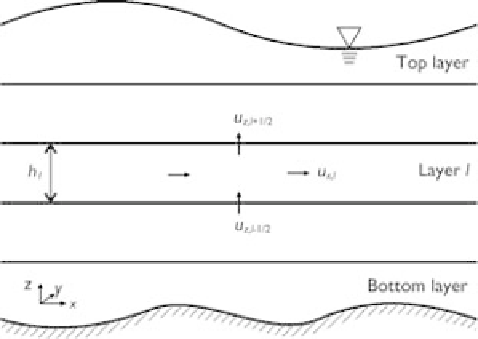Geoscience Reference
In-Depth Information
Cheng (1992), Jankowski
et al
. (1994), Lin and Falconer (1996), and Shanhar
et al
.
(2001) are based on this assumption.
Note that in the set of equations (7.18)-(7.20), the water level replaces the pressure in
the momentum equations, but it does not appear in the continuity equation. This weak
linkage between water level and velocity may produce node-to-node (checkerboard)
numerical oscillations if not handled carefully. Approaches used to solve this set of
equations are described below.
7.2.1 Layer-integrated model
The layer-integrated model divides the water depth into a number of layers, as shown
in Fig. 7.3. The layer interfaces are usually horizontal planes with constant altitudes,
and the
z
-coordinate directs vertically. The thicknesses of the top and bottom layers are
variable to track the temporal and spatial changes in water surface and channel bed.
The grid is staggered with the vertical velocity stored at layer interfaces. Integrating
Eqs. (7.18)-(7.20) over each layer yields (Shanhar
et al
., 2001)
u
z
,
l
−
1
/
2
−
∂
∂
)
−
∂
∂
u
z
,
l
+
1
/
2
=
x
(
h
l
u
x
y
(
h
l
u
y
)
(7.21)
∂
∂
)
+
∂
∂
h
l
u
x
)
+
∂
∂
gh
l
∂
z
s
t
(
h
l
u
x
x
(
y
(
h
l
u
y
u
x
)
+
(
u
z
u
x
)
l
+
1
/
2
−
(
u
z
u
x
)
l
−
1
/
2
=−
∂
x
τ
τ
1
ρ
∂
∂
1
ρ
∂
∂
xz
ρ
xz
ρ
+
x
(
h
l
τ
)
+
y
(
h
l
τ
)
+
2
−
2
+
f
c
h
l
u
y
(7.22)
xx
xy
l
+
1
/
l
−
1
/
∂
∂
)
+
∂
∂
)
+
∂
∂
gh
l
∂
z
s
h
l
u
y
)
+
(
t
(
h
l
u
y
x
(
h
l
u
x
u
y
y
(
u
z
u
y
)
l
+
1
/
2
−
(
u
z
u
y
)
l
−
1
/
2
=−
∂
y
τ
τ
1
ρ
∂
∂
1
ρ
∂
∂
yz
ρ
yz
ρ
+
x
(
h
l
τ
yx
)
+
y
(
h
l
τ
yy
)
+
2
−
2
−
f
c
h
l
u
x
(7.23)
l
+
1
/
l
−
1
/
where
h
l
is the thickness of the
l
th layer.
Figure 7.3
Configuration of layer-integrated model.








